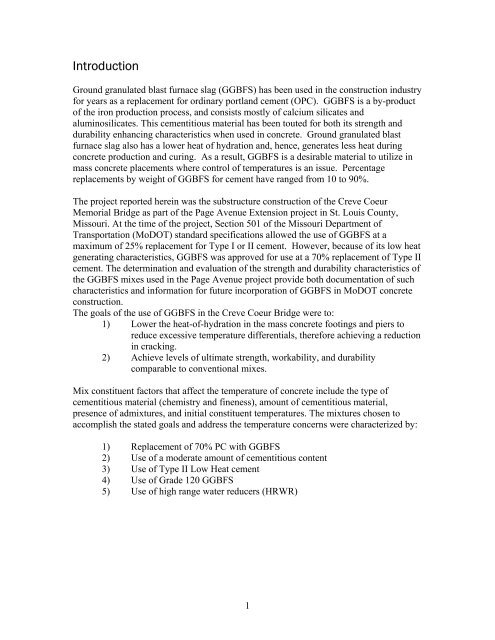Strength and Durability of a 70% Ground Granulated Blast Furnace ...
Strength and Durability of a 70% Ground Granulated Blast Furnace ...
Strength and Durability of a 70% Ground Granulated Blast Furnace ...
You also want an ePaper? Increase the reach of your titles
YUMPU automatically turns print PDFs into web optimized ePapers that Google loves.
Introduction<br />
<strong>Ground</strong> granulated blast furnace slag (GGBFS) has been used in the construction industry<br />
for years as a replacement for ordinary portl<strong>and</strong> cement (OPC). GGBFS is a by-product<br />
<strong>of</strong> the iron production process, <strong>and</strong> consists mostly <strong>of</strong> calcium silicates <strong>and</strong><br />
aluminosilicates. This cementitious material has been touted for both its strength <strong>and</strong><br />
durability enhancing characteristics when used in concrete. <strong>Ground</strong> granulated blast<br />
furnace slag also has a lower heat <strong>of</strong> hydration <strong>and</strong>, hence, generates less heat during<br />
concrete production <strong>and</strong> curing. As a result, GGBFS is a desirable material to utilize in<br />
mass concrete placements where control <strong>of</strong> temperatures is an issue. Percentage<br />
replacements by weight <strong>of</strong> GGBFS for cement have ranged from 10 to 90%.<br />
The project reported herein was the substructure construction <strong>of</strong> the Creve Coeur<br />
Memorial Bridge as part <strong>of</strong> the Page Avenue Extension project in St. Louis County,<br />
Missouri. At the time <strong>of</strong> the project, Section 501 <strong>of</strong> the Missouri Department <strong>of</strong><br />
Transportation (MoDOT) st<strong>and</strong>ard specifications allowed the use <strong>of</strong> GGBFS at a<br />
maximum <strong>of</strong> 25% replacement for Type I or II cement. However, because <strong>of</strong> its low heat<br />
generating characteristics, GGBFS was approved for use at a <strong>70%</strong> replacement <strong>of</strong> Type II<br />
cement. The determination <strong>and</strong> evaluation <strong>of</strong> the strength <strong>and</strong> durability characteristics <strong>of</strong><br />
the GGBFS mixes used in the Page Avenue project provide both documentation <strong>of</strong> such<br />
characteristics <strong>and</strong> information for future incorporation <strong>of</strong> GGBFS in MoDOT concrete<br />
construction.<br />
The goals <strong>of</strong> the use <strong>of</strong> GGBFS in the Creve Coeur Bridge were to:<br />
1) Lower the heat-<strong>of</strong>-hydration in the mass concrete footings <strong>and</strong> piers to<br />
reduce excessive temperature differentials, therefore achieving a reduction<br />
in cracking.<br />
2) Achieve levels <strong>of</strong> ultimate strength, workability, <strong>and</strong> durability<br />
comparable to conventional mixes.<br />
Mix constituent factors that affect the temperature <strong>of</strong> concrete include the type <strong>of</strong><br />
cementitious material (chemistry <strong>and</strong> fineness), amount <strong>of</strong> cementitious material,<br />
presence <strong>of</strong> admixtures, <strong>and</strong> initial constituent temperatures. The mixtures chosen to<br />
accomplish the stated goals <strong>and</strong> address the temperature concerns were characterized by:<br />
1) Replacement <strong>of</strong> <strong>70%</strong> PC with GGBFS<br />
2) Use <strong>of</strong> a moderate amount <strong>of</strong> cementitious content<br />
3) Use <strong>of</strong> Type II Low Heat cement<br />
4) Use <strong>of</strong> Grade 120 GGBFS<br />
5) Use <strong>of</strong> high range water reducers (HRWR)<br />
1

















